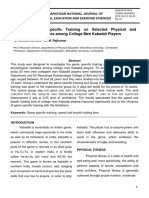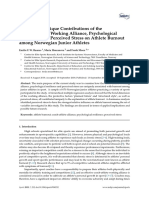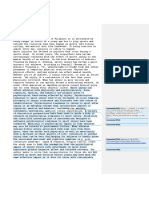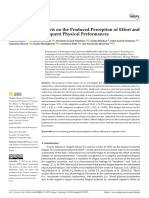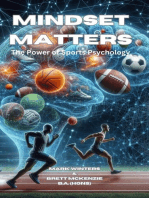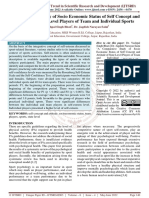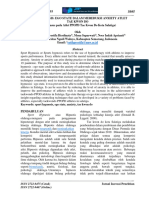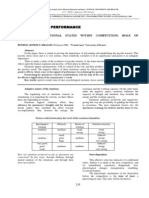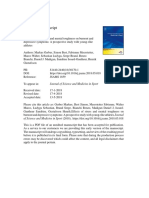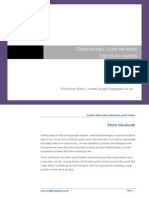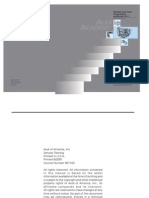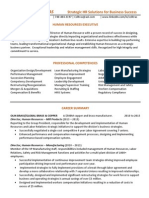Professional Documents
Culture Documents
Composite Effects of Performance Related Anxiety and Mental Fatigue in Performance Trend of Air Rifle Shooters
Original Description:
Copyright
Available Formats
Share this document
Did you find this document useful?
Is this content inappropriate?
Report this DocumentCopyright:
Available Formats
Composite Effects of Performance Related Anxiety and Mental Fatigue in Performance Trend of Air Rifle Shooters
Copyright:
Available Formats
Volume 7, Issue 10, October – 2022 International Journal of Innovative Science and Research Technology
ISSN No:-2456-2165
Composite Effects of Performance Related
Anxiety and Mental Fatigue in Performance
Trend of Air Rifle Shooters
Ms. Debleena Ghosh.1, Ms. Sayantika Das1, Ms. Upasana Chowdhury.1, Mr. Subhankar Banerjee.1
and, Professor Dr. Somnath Gangopadhyay.1*
1
Occupational Ergonomics Laboratory, Department of Physiology, University of Calcutta, West Bengal, India
92, APC Road. Kolkata- 700009
Abstract:- Shooting is a physically and psychologically Keywords:- Beginners, Concentration Disruption, Critical
taxing sport. This study serves to establish an integrated Flicker Fusion Frequency, Elites, Mental Toughness,
relationship of the aforementioned psychosocial factors Recreational shooters, Somatic Trait Anxiety, Sports Anxiety
on the performance score of Air-Rifle Shooters and Scale.
compare the distribution, variation and association of the
said parameters among the three selected categories of I. INTRODUCTION
rifle shooters, based on the years of their experience: elite,
recreational shooters and beginner shooters. 45 shooters There are many people across the world, involved with
were randomly selected from a regional shooting club in activities of shooting, whether in terms of profession or as an
West Bengal, Kolkata. The Sports Anxiety Scale (SAS) athlete participating in a sports competition.
Questionnaire, was administered and their pre practice
and post practice mental fatigue levels was measured According to Silva et al.[1] rifle shooting is an activity
using the Critical Flicker Fusion Frequency (CFFF) of precision ,which not only needs immense motor control
apparatus. ,but also requires a great level of concentration , to focus and
hit the target .Rifle shooting is governed by numerous factors
What we already know .Hence, various, variable whether physical :body balance
Rifle shooting is a visually engaging sport, that ,grip strength ,posture etc. or psychosocial :mental fatigue
requires absolute focus and concentration of the ,anxiety ,self- control could each influence the performance
marksmen to not only hit the target at hand with of the competitive rifle shooters.
utmost accuracy but also to ensure the safety of the
other shooters present at the range. Thus, mental fatigue and anxiety both associated with
It is an intricate activity coupling body balance , performance is one of the most studied topics in sports
postural stability and self- control maintained over psychology, and it continues to be a key focus of research for
prolonged periods of time. researchers and consultants throughout the world.[2]
Hence various psychosocial factors such as anxiety and
Mental fatigue often leaves a shooter predisposed to According to Martens(1977),Competitive anxiety can
impaired marksmanship and overall deterioration. be described as a sport specific trait anxiety that occurs on a
regular basis ,before or during a competition .Competitive
What this article adds anxiety ,such as state and trait anxiety ,can occur at the
Hence it can be concluded that the shooters have physical or cognitive level ,according to the
developed a level of immunity against visual/ mental ‘Multidimensional anxiety theory’, on the other hand
fatigue regardless of their seniority in the field. ,somatic anxiety relates to physical reactions to over-
This study also reveals that a significant psychological activation ,such as muscle tightness.[2],[3]
load is experienced by both the beginners and elite
groups of shooters however, such psychological loads Fatigue being a significant determinant of sporting
in the form of “Competition related anxiety” may performance, has been defined as a “reduced capacity of
positively modulate the performance scores in the maximal performance.” Fatigue is a multifaceted
elites and the beginner alike, as shown by the negative phenomenon that has been shown to affect performance in a
correlation of the performance scores to the various variety of tasks .Fatigue does not always originate in the
SAS Scores. neuromuscular system .Hence it can be concluded that Mental
Eustress and Distress both positively and negatively Fatigue is a psychobiological state generated by prolonged
regulates a shooter’s performance. periods of intensive cognitive exertion.[4]
IJISRT22OCT309 www.ijisrt.com 285
Volume 7, Issue 10, October – 2022 International Journal of Innovative Science and Research Technology
ISSN No:-2456-2165
It is also stated, that fatigue can be classified as acute or comprised of 13-32 years, while that in beginner group
chronic depending on how long it lasts. Acute fatigue is comprised of 10-17 years and in the recreational group
quickly relieved by a break or a change in lifestyle ,however comprised of mainly 42-57 years.
chronic fatigue is a state of persistent exhaustion that lasts
months and cannot be cured by rest .Exhaustion has also been The Sport Anxiety Scale (SAS-2)
divided into two types: mental weariness ,which refers to The (SAS-2)evaluates player’s competitive trait anxiety
cognitive or perceptual aspects of fatigue ,and physical before and during competition . Somatic anxiety ,worry and
fatigue, which refers to the actualization of the motor concentration interruption are all the elements on the scale .
structure .Muscle tiredness occurs when a muscle’s ability to It is a 15 –item questionnaire and each item relating to the
operate or its ability to create force decreases with time .In statement is rated by the participants on a four-point Likert
response to contractile motion .It has also been described as scale.[ 6],[9 ],[10],[11]
a reduction in the power creation .The force behind muscular
actions reduces when weariness sets in ,leading to a sense in The aforementioned questionnaire was administered to
vulnerability.[5] measure the sport- specific cognitive and somatic trait anxiety
in this study .The digitized version of this questionnaire was
Similarly, anxiety related to a competition or circulated amongst the participants via Google forms; these
performance has been established as a significant predictor of forms were mainly circulated through social media
the quality and duration of one’s experiences in sports and messaging apps like WhatsApp and Gmail.
other success domains such as music , academics ,and
businesses .In both adults and children, high levels of The Critical Flicker Fusion Frequency Test (CFFF)
competitive anxiety are linked to poor performance and Flicker instrument (Model 501c. Takei Kiki Kogyo Co.
diminished enjoyment of involvement. It was also concluded Ltd, Japan) was used to perform the CFFF test. The CFFF test
that anxiety coupled with Sport attrition can have serious determines the rate at which successively flickering fusion
negative repercussions for youngsters, including a decline in events, when a light stimuli is applied on the retina occurs
healthy physical activity and involvement in deviant .The measure of this rate is expressed in (Hz) and is best
behaviors and is also a predictor of sports participation known as the “threshold frequency” and often serves as an
termination.[6],[7],[8] index of the activity of the central nervous system .[12],[13],[14]
In this paper we have attempted to establish the impact CFFF has been widely used in the field of ergonomics
of mental fatigue and sport associated anxiety on the and occupational health, as a standard measure of mental
performance (score), among various age groups of fatigue .[12] The participants of the present study were asked
competitive rifle shooters, during their practice sessions prior to take a 15 minutes break prior to the start of the practice
to the upcoming state level tournaments. sessions and just before they entered the shooting range to
practice, their CFFF scores were recorded ,following which
The objectives of this study are as follows: (a) To check after a span of an hour their performance scores on the score
whether there is a significant variation in the values of CFFF, cards were recorded as well .Thereafter, midway between
of the elite shooters at the start and towards the end of the their practice session their CFFF scores were recorded yet
practice sessions, held prior to their participation in the again ,followed by their performance scores .
upcoming qualifying state tournaments, (b) To test if the
variation in the CFFF values is consistent among different Statistical Analysis:
groups of rifle shooters i.e. elites, recreational and beginner, To perform the statistical analysis on the data, SPSS
(c) To test if there is a significant variation in the performance version 24 was used.
score among elites, recreational and beginner groups of rifle
shooters based on their years of experience, (d) To compare Independent –Samples Kruskal –Wallis test was
the variation in SAS (Stress Anxiety Score), among the performed to check whether the distribution of “before
aforementioned categories and establish a relation with the practice” CFF (Critical Flicker Frequency), “after” CFF
performance score. (Critical Flicker Frequency) and the distribution of “before
practice” CFF (Critical Fusion Frequency),“after practice ”
II. METHODS CFF (Critical Fusion Frequency),is the same across a
particular category of shooters. Mann-Whitney test [16]was
Participants Selection applied to investigate the probability of the randomly
A total of 45 air rifle shooters aged 10-55 years ( mean selected values of “before practice ” CFF (Critical Flicker
age 34 ± 3.3 years) were randomly selected from a regional Frequency) being greater than values of “after practice” CFF
shooting training club of West Bengal. With 15 shooters (Critical Fusion Frequency), in both “UP” and “DOWN”
belonging to the elite group,15 belonging to the recreational modes. Independent –Samples Kruskal –Wallis test was used
group of shooters and the rest 15 were beginner .each group to check the significance of differences, in the various SAS
comprising of male and female alike ,but comprising of scores (Somatic Anxiety Score, Competition Anxiety Score,
different age categories. In the elite’s group, there were a total Concentration Disruption Score), between various categories
of 11 males and 4 females, the recreational group of shooters of rifle shooters. Spearman Correlations was used to check
all were males, while in the beginner’s group 7 were females the association of various SAS scores with the shooters
and 8 were males. The age group of elite shooters mainly performance scores and the significance levels were tested at
IJISRT22OCT309 www.ijisrt.com 286
Volume 7, Issue 10, October – 2022 International Journal of Innovative Science and Research Technology
ISSN No:-2456-2165
the 0.05 level (2-tailed).Wilcoxon signed rank test was done , it was observed that there lied a statistically significance
to perform pair-wise comparisons of the differences of values levels of .002,.001,.020 and .002 respectively given that
in the pre and post practice session Critical Flicker and Fusion (p<.05) .
Frequencies (Hz) across the categories of type.
Table 1 shows pair wise comparison of various SAS
III. RESULTS scores such as (Somatic Trait Anxiety, Worry and
Concentration Disruption Scores) among the Recreational,
Upon conducting the Independent-Samples Kruskal Beginner and Elite shooters there exists a statistically
Wallis Test to check if the distribution of the various SAS significant difference of in the Somatic Trait Anxiety scores,
scores (Somatic Anxiety, Worry, Concentration Disruption) Concentration Disruption Scores and Worry Scores among
and Performance scores across the categories of rifle shooters the Recreational and Beginner group of Rifle Shooters.
Sample 1&2 Test Statistic Std. Error Std.Test Sig. Total N: 45
Statistic
Somatic Anxiety
Score
R-E -9.089 4.789 -1.901 .057 Test Statistic:14.852
R-B -16.642 4.696 -3.544 .000 Degree Of Freedom :2
E-B -7.552 4.855 -1.556 .120 Asymptotic Sig. : **.001
Concentration
Disruption Score
R-E -1.027 4.767 -.215 .829 Test Statistic**: 13.003
R-B -11.979 4.681 -2.559 .010 Degree of Freedom : 2
E-B -10.952 4.840 -2.263 .024 Asymptotic Sig. : .002
Worry Score
R-E -2.138 4.792 -.446 .655 Test Statistic**: 7.841
R-B -16.848 4.706 -3.580 .000 Degree of Freedom: 2
E-B -14.710 4.866 -3.023 .003 Asymptotic Sig : .020
*Significance values have been adjusted using Bonferroni correction for multiple tests.
** The test statistic is adjusted for ties.
Table 1:- Pair wise Comparisons of Somatic SAS scores among different categories of rifle shooters, where R stands for
recreational, E stands for elite and B stands for Beginner shooters .The significance level is (.05)
From the computation of Spearman’s correlation performance scores to the various SAS scores among the
coefficient (Table 2), it was found that there existed a Recreational, Elites and Beginner groups of rifle shooters.
statistically significant negative correlation of the
Category Spearman’s Correlation Coefficient Sig. Level at
Performance Somatic SAS Worry SAS Concentration (0.05) *
Score Disruption
1.000 -.385 -.521 -.370.009, .000, .012
N=45
RECREATIONAL 1.000 -.234 -.399 -.191 .382, .126, .479
n=15
ELITE 1.000 -.311 -.274 -.252 .279, .343, .385
n=15
BEGINNERS 1.000 .063 -.078 -.079 .824, .781, .780
n=15
* Significance levels of Somatic SAS, Worry SAS and Concentration Disruption, respectively.
Table 2:- Computation of Spearman’s correlation coefficient between the SAS scores (worry, somatic trait and concentration
disruption) and the Performance Scores.
IJISRT22OCT309 www.ijisrt.com 287
Volume 7, Issue 10, October – 2022 International Journal of Innovative Science and Research Technology
ISSN No:-2456-2165
However the results obtained from the statistical analysis of Also as evident from Table 3, the statistical analysis of
the frequencies of the Critical Flicker and Critical Fusion in differences between the pre practice Critical Flicker and
(Hz) by the Independent Samples Kruskal Wallis Test, Critical Fusion Frequencies (Hz), across the categories of
obtained during pre practice sessions and post practice types of shooters, there lies a statistically significant
sessions, in both “Fusion” and “Flicker” modes shows that difference in the values of post practice Critical Fusion
there lies a statistically insignificant variations of .593, .118, Frequencies (Hz) in “Flicker” mode , among the Recreational
.530, .454 given that (p<.05) in the values of Critical Flicker groups of shooters. While a statistically significant difference
and Critical Fusion Frequencies (Hz) across the various in values of post practice Critical Flicker Fusion Frequencies
categories of the types of rifle shooters, based on their years were reported in recreational and beginner level shooters,
of experience. respectively.
Category of Mann-Whitney U Wilcoxon W Z score
shooter Difference in values Difference in values Difference in values
( Pre and post practice in Hz) ( Pre and post practice in Hz) ( Pre and post practice in Hz)
Critical Flicker Critical Fusion Critical Flicker Critical Fusion Critical Critical Fusion
Frequency Frequency Frequency Frequency Flicker Frequency
Frequency
Elite 76.000 105.000 196.000 225.000 -1.520 -.312
Recreational 101.500 107.000 221.500 227.000 -.458 -.230
Beginners 80.500 103.500 200.500 223.000 -1.336 -.376
Total N =45 766.000 1004.500 1801.000 2039.000 -1.996 -.065
Table 3:- Analysis of differences of values in the pre and post practice session Critical Flicker and Fusion Frequencies (Hz) across
the categories of type
IV. DISCUSSION “Reinvestment Perspective Theory” as proposed by Elton
Eustaquio Casagrande and Fernando Valvano Cerezetti,
[15],[16]
This study investigated the variation of SAS scores and As proficiency increases, in the skill, our specialized
CFF Frequencies among various categories of rifle shooters knowledge, about what needs to be done to do the task gets
based on their years of experience in the sport and its more subconscious, and we can smoothly and efficiently
association with the performance scores/ performance trend. carry on with the task. On another note a proficient performer
In Table 3, we see that the distribution of somatic trait SAS (here being referred to as an elite shooter) has reached
varied across the categories of riffle shooters, with a automaticity and is thus able to do skills subconsciously and
significance level of .002. This observation can be supported smoothly. When talented performers become tensed or
by the fact that these two categories of shooters were the ones nervous, they tend to reinvest attention in their competence
having most experience as opposed to the beginner shooters by going along the laid rules of a sport, regressing a skilled
and years of competing in various tournaments and years of performance to a level lower than their proficiency, resulting
consistent practice have conditioned their bodies to withstand in performance deficiencies.
the physiological effects anxiety associated with competitive
performance that may present itself in the form of Similarly, when pair wise comparison of worry SAS
restlessness, palpations, upset stomach, trembling in the scores among different categories of rifle shooters (table -6),
limbs etc. Here, the two categories of concern: elites and were carried out, an insignificant difference of 1.000 was
recreational shooters each have a minimum experience of ten reported among recreational and elite shooters, while a
years and twenty year’s worth of experience at most. significant difference of .001 was reported amongst
recreational and beginner shooters. As the recreational
On the other hand when the somatic trait SAS scores, shooters are mostly composed of athletes who have retired
between the recreational and beginner groups of shooters from the sport and are now free from competitive stress, as
were compared, a significance value of .001 was reported as opposed to beginner who have little to no experience in
evident from Table 3. This can be attributed to the difference competitive shooting as they have just enrolled and are
in the seniority and mental toughness among the two preparing to qualify for the preliminary rounds. Their
categories of rifle shooters. As inferred from the SAS-2 inexperience added with their self- inhibitions, take a toll on
questionnaire administered, the beginners are most concerned their psyche and thus hinder them from giving their best in
over their ability to withstand the hectic training schedule and the performance.
qualify for the future tournaments.
We also found from Table 3, that the beginner and elite
On the contrary, there was no significant difference shooter’s worry SAS scores, showed an insignificant
found in the somatic trait SAS scores of the elite and the difference of .008. As proposed by the “Theory of Ironic
beginner. This observation can be based on the Process of Mental Control”(TIP) by Zhang et al. [17]
IJISRT22OCT309 www.ijisrt.com 288
Volume 7, Issue 10, October – 2022 International Journal of Innovative Science and Research Technology
ISSN No:-2456-2165
[18],[19],[20]
When anxiety is low, conscious resources are shooters must maintain attention throughout a tournament,
available, allowing the monitoring process to reactivate the which typically lasts many hours and long-term self-
operating process, allowing purposeful control toward the control/discipline (i.e., a subjective estimate of how much
desired states to be maintained. In short, we are more likely mental effort, one is capable of spending in a given task).
to accomplish our goals, ace a competition when there is little
cognitive burden on us, if we were to take a beginner’s Further the environment where the data was recorded
perspective into consideration the cognitive load would also may have played a key role in modulating the athlete’s
probably stem from trying too hard to meet one’s mental fatigue levels, as the practice sessions on the shooting
parent’s/coach’s expectations, trying too hard to qualify for range on the day of data collection was merely a simulation
the competition etc. Such thoughts, often gives rise to a high before the actual state level competitions were to be held,
cognitive burden which consumes a considerable percentage giving much time for the athletes to de stress and take
of the limited conscious resources, suppressing the occasional breaks in-between practice sessions so by the time
operational process and limiting the execution of the skills the after performance Critical Flicker and Critical Fusion
and the application of knowledge one has to ace a Frequency was recorded the mental fatigue which may have
competition/task. occurred, had already worn off.
Also as inferred from Table 3, the pair wise comparison V. CONCLUSION
of concentration disruption scores, shows no significant
difference (0.829) among the recreational and elite group of From this study it is concluded that the distribution of
shooters, but shows a significant difference of .010, among somatic trait SAS varied between the groups of rifle shooters
beginner and recreational group of shooters as well as elite .This is due to the disparity in years of experience and mental
and beginner group of rifle shooters showing a significant toughness between the two groups of rifle shooters. The
statistical significance of .024. This observation can be beginners are most anxious about their capacity to handle the
justified by the findings from the SAS-2 questionnaire, for stress of the training regimen and qualify for the preliminary
concentration disruption, here the beginner owing to their rounds of future competitions .The elite and beginner’s
untrained psyche, are more prone to succumb to wandering somatic trait SAS scores, on the other hand, did not differ
thoughts that may interfere with their concentration and significantly. However, as far as the elites and recreational
intervene with them properly focusing on the targets These shooters are concerned concentration disruption arising from
findings were consistent with “The Distraction Perspective” worries of not being able to maintain their rank, can serve as
theory as stated by Fergus I.M.Craik,[21],[22],[23]. It is also to be a motivator, since the fear of failing can lead to reallocation
noted that our study found a significant negative correlation of additional cognitive resources, prompting the athletes to
between the performance score and the SAS scores as a whole surpass their potential and hence maintain a steady
as depicted in Table 4, however upon further associating the performance when apprehensive.
performance score with the three SAS scores category wise,
the association of performance score and the three SAS scores However analysis of CFFF frequencies in both flicker
among the elites and recreational shooters remained majorly and fusion mode reveal statistically insignificant variations
insignificant, while the association of beginner’s across the categories of type indicating a strong level of
performance score to SAS scores showed no statistically immunity against mental fatigue, irrespective of years of
significant correlation. experience.
Following, the variations in SAS scores among Ethical Approval
categories, this study also attempted to test if there existed This study was approved by the Institutional Human
variations in the distribution of mental fatigue measured Ethics Committee of the Department of Physiology,
through Critical Flicker Frequency and Critical Fusion University of Calcutta, ‘Ref No IHEC/SG/01/2022’ dated
Frequency readings (in Hz), across the categories of type, and 3.8.2022 and written informed consent was obtained from all
it was discovered that the distribution of both before and after the subjects.
practice Critical Flicker Frequency and Critical Fusion
Frequency readings (in Hz), was the same across categories Future Research
of type with the significance levels being .593,.118,.530 and The following research needs have been identified:
.454 respectively as evident in Table 6. Studies must be conducted to investigate the role of
nutritional status in the improvement of the ocular health
Also, the analysis of differences between the before of the shooters.
practice Critical Flicker Frequency and Critical Fusion Formulation of training plans based on the performance in
Frequency readings (in Hz) and after practice Critical Flicker competitions.
Frequency and Critical Fusion Frequency (in Hz); revealed Design of Ergonomically Fit layout of shooting ranges.
insignificant results for each of the categories. The result is
probably owing to the ‘ mental toughness’ of the athletes as ACKNOWLEDGEMENTS
stated by Chris Englert et al. [24],[25], and the visually engaging
nature of the sport requiring on to steadily focus on a small The conception of this project was brought to fruition
target placed at a distance of ten-fifty m depending on the through tireless assistance of many people.
type of air rifle shooting one chooses to compete in. Elite
IJISRT22OCT309 www.ijisrt.com 289
Volume 7, Issue 10, October – 2022 International Journal of Innovative Science and Research Technology
ISSN No:-2456-2165
We are most grateful to the various participants of States." Health Behavior and Policy Review. 2016
“NORTH CALCUTTA RIFLE CLUB”, for having March; 3(2):88-98. DOI:10.14485/HBPR.3.2.1.
participated in this research and sparing their valuable time to [9]. Tomczak M, Kleka P, Walczak A, Bojkowski L, Gracz
share their insights. Their valuable assistance is what J & Walczak M “Validation of Sports Anxiety Scale-2
prompted the smooth execution of this study. We are grateful (SAS-2) Among Polish Athletes and the Relationship
beyond words for all the valuable suggestions and made by between Anxiety and Goal Orientation in Sport.”
our guide Prof. Dr. Somnath Gangopadyay. It was through Scientific Reports. 2022 July 19; 12: 12281.
his creative inputs that this study was first conceptualized. [10]. Cho S, Choi H, Eklund RC, Paek I “Validation and
Reliability of the Korean Version of the Sport Anxiety
Declaration of Conflicting Interests Scale-2” Journal of Human Kinetics. 2018 March; 61:
The author(s) declare no potential conflicts of interest 217-225. DOI: 10.1515/hukin-2017-0138.
with respect to the research, authorship, and/ or publication [11]. Woodman T and Hardy L. “The Relative Impact of
of this article. Cognitive Anxiety and Self –Confidence upon Sport
Performance: a meta analysis.” School of Sport,
Funding: Healthy and Exercise Sciences, University of Wales,
The author(s) have received no financial support for the Bangor, Gwynedd Ll57 2DG,UK. 2003 February 21;
research, authorship, and/ or publication of this article 443-457.DOI: 10.1080/264041031000101809.
[12]. Endukuru CK, K N Maruthy, T S Deepthi. “A Study
REFERENCES of Critical Flickering Fusion Frequency Rate in Media
Players.” International Journal Of Multidisciplinary
[1]. Moreira da Silva F, Malico Sousa P, Pinheiro VB, Research Development. 2015 May; 2(5): 499-502.
López-Torres O, Refoyo Roman I, Mon-López D. [13]. Mankowska ND, Marcinkowska AB, Waskow M et
Which are the most determinant psychological factors al.“Critical Flicker Fusion Frequency: A Narrative
in olympic shooting performance? A self-perspective Review.” Medicina. 2021 October 13; 57:1096.
from elite shooters. International Journal of [14]. Iwaki S, Harada N. “ Mental Fatigue Measurement
Environmental Research and Public Health. Based on The Changes In Flicker Perception Threshold
2021;18(9):4637. doi:10.3390/ijerph18094637 Using Consumer Mobile Devices.” Advanced
[2]. Ramis Laloux Y, Viladrich Segués MC, Sousa CD, Biomedical Engineering. 2013; 2:137-142.
Jannes C. Exploring the factorial structure of the Sport [15]. Shuge Z, Woodman T, Roberts R, “ Anxiety and Fear
Anxiety Scale-2: Invariance across language, gender, In Sports Performance .” Oxford Research
age and type of sport. Psicothema. 2015.27(2) : 174-181 Encyclopedia of Psychology .” Oxford University
[3]. Miller SR and Kris Chesky K. “An Assessment of and Press. 2018 December. DOI:
Relationships Between Intensity and Direction of 10.1093/acrefore/9780190236557.013.162
Cognitive Anxiety, Somatic Anxiety, and Self– [16]. Masters R and Maxwell J.“ The Theory of
Confidence over Multiple Performance Requirements Reinvestment.” International Review of Sport and
among College Music Majors.”Medical Problems of Exercise Psychology. 2008 September 09; 1(2): 160-
Performing Artists. 2004 march; 19(1):12-20. DOI: 183. DOI: 10.1080/17509840802287218.
10.21091/mppa.2004.1003 [17]. Gorgulu R, CookeA, and Woodman T. “Anxiety and
[4]. Russell S, Jenkins D, Smith M, Halson S, Kelly V. “The Ironic Errors of Performance: Task Instruction
application of mental fatigue research to elite team sport Matters.” Journal of Sport and Exercise Psychology.
performance: New perspectives.” J Sci Med Sport. 2019 2019 April; 41(2):82-95. DOI: 10.1123/Jsep.2018-
June; 22(6):723-728. DOI: 0268.
10.1016/j.jsams.2018.12.008. [18]. Wegner DM, Erber R, Zanakos S.“Ironic Processes in
[5]. Syed I, Azhar AS, Muneer AS, Kaleem AS, the Mental Control of Mood and Mood-Related
Habeebullah M. “Fatigue: Impact Of Muscular Co- Thought.” Journal of Personality and Social
Ordination Among Rifle Shooters.” International Psychology. 1994 January ; 65(6):1093-104.
Journal Of Pharmaceutical Research And Allied DOI:10.1037//0022-3514.65.6.1093.
Sciences. 2019 January 1;8 (1): 123-128. [19]. Wang DA , Hagger MS , Chatzisarantis NLD . “Ironic
[6]. Smith, Smoll RE, Cumming FL, Grossbard SP, Joel R. Effects of Thought Suppression: A Meta-Analysis.”
“Measurement of Multidimentional Sport Performance 2020 May;15(3):778-793. DOI:
Anxiety In Children And Adults: The Sport Anxiety 10.1177/1745691619898795.
Scale-2.”Journal of Sport and Exercise Physiology. [20]. Craik FI . “Effects of distraction on memory and
2006; 28(4):479-501. cognition: a commentary.” Frontiers in
[7]. Balish SM, Mclaren C, Rainham D, Blanchard Psychology. 2014 July 9; 5:
C.“Correlates of Youth Sport Attrition: A Review and 841. DOI: 10.3389/fpsyg.2014.00841.
Future Directions.” Psychology of Sport and Exercise. [21]. Hagen JW.“The Effect of Distraction on Selective
2014 April 14;15: 429-439. Attention.” Child Development. 1967 September; 38(3):
[8]. Sabo D and Veliz P.“Inequalities in Athletic 685-694.
Participation during Adolescence: A Nationwide Study [22]. Englert C, Dziuba A, Gibbon L-S, Wolff W. “ Elites Do
of Attrition Rates in Organized Sports in the United Not Deplete - No Effect of Prior Mental Exertion on
Subsequent Shooting Performance In Elite
IJISRT22OCT309 www.ijisrt.com 290
Volume 7, Issue 10, October – 2022 International Journal of Innovative Science and Research Technology
ISSN No:-2456-2165
Shooters.”Frontiers in Psychology. 2021 June 11;
12:668108. DOI: 10.3389/fpsyg.2021.668108.
[23]. Liew GC, Kuan G, Chin NS and Hashim HA. “Mental
toughness in sport.” German Journal of Exercise and
Sport Research. 2019 July 17; 49:381–394.
[24]. Thelwell RC, Greenlees I.“Developing Competitive
Endurance Performance Using Mental Skills Training.”
Sport Psychologist. 2003 September; 17(3):318-337.
DOI:10.1123/tsp.17.3.318.
[25]. Mahoney JW , Gucciardi DF, Ntoumanis N, Mallett
CJ. “Mental toughness in sport: motivational
antecedents and associations with performance and
psychological health.”Journal of Sports and Exercise
Psychology.2014 Jun; 36(3):281-92. DOI:
10.1123/jsep.2013-0260.
IJISRT22OCT309 www.ijisrt.com 291
You might also like
- Smith 2018. Metal Fatugue and SoccerDocument8 pagesSmith 2018. Metal Fatugue and SoccerLorenna BarroNo ratings yet
- Evaluation of Self-Efficacy, Physical Activity Participation and Return To Sports For An ACL Injury in Indian Male AthletesDocument13 pagesEvaluation of Self-Efficacy, Physical Activity Participation and Return To Sports For An ACL Injury in Indian Male AthletesInternational Journal of Innovative Science and Research TechnologyNo ratings yet
- General Psychological Factors Affecting Physical Performance and SportsDocument11 pagesGeneral Psychological Factors Affecting Physical Performance and SportsMonaNo ratings yet
- TPERJ Vol 13 Issue 25 Art 1Document10 pagesTPERJ Vol 13 Issue 25 Art 1Mamoona GullNo ratings yet
- Objective: The Aim of This Article Was To Review The Literature To Estimate (1) IfDocument20 pagesObjective: The Aim of This Article Was To Review The Literature To Estimate (1) IfMaria Beatriz Duarte GaviãoNo ratings yet
- Afizan Amerresearch 2Document6 pagesAfizan Amerresearch 2Mini WilfredNo ratings yet
- Toward A Psychophysiology of Performance - Sport Psychology Principles Dealing With AnxietyDocument16 pagesToward A Psychophysiology of Performance - Sport Psychology Principles Dealing With Anxietywan nazrolNo ratings yet
- 1 s2.0 S0747563224000062 MainDocument9 pages1 s2.0 S0747563224000062 Mainviraaulia040No ratings yet
- Evaluation of A Psychological Skill Training Program On Mental Toughness and Psychological Wellbeing For Professional Soccer PlayersDocument8 pagesEvaluation of A Psychological Skill Training Program On Mental Toughness and Psychological Wellbeing For Professional Soccer PlayersAlpesh JadhavNo ratings yet
- PST ExampleDocument15 pagesPST ExampleBadrul WahabNo ratings yet
- Trends Assessing Neuromuscular Fatigue in Team Sports - A Narrative ReviewDocument15 pagesTrends Assessing Neuromuscular Fatigue in Team Sports - A Narrative ReviewChristian HazaldineNo ratings yet
- 37 Iajps37102020Document9 pages37 Iajps37102020iajpsNo ratings yet
- Ann. Appl.-V3n4p9-EnDocument10 pagesAnn. Appl.-V3n4p9-EnNik 19No ratings yet
- Anxiety Status of Junior Archers in COVID-19 During Training Isolation Period Towards The Shooting PerformanceDocument10 pagesAnxiety Status of Junior Archers in COVID-19 During Training Isolation Period Towards The Shooting PerformanceIJPHSNo ratings yet
- Mindfulness With Collegiate Gymnasts - Effects On Flow, Stress and Overall Mindfulness LevelsNicholas P. Cherupa,, Zeljka VidicDocument13 pagesMindfulness With Collegiate Gymnasts - Effects On Flow, Stress and Overall Mindfulness LevelsNicholas P. Cherupa,, Zeljka VidicGABRIELNo ratings yet
- Marcora 2009Document9 pagesMarcora 2009pacoNo ratings yet
- Effects of Anxiety On Athletic Performance: CRI SONDocument5 pagesEffects of Anxiety On Athletic Performance: CRI SONjundieNo ratings yet
- 5150 35251 1 PBDocument10 pages5150 35251 1 PBitsmeshairaNo ratings yet
- Module 4Document3 pagesModule 4Chenlie VillamenteNo ratings yet
- Mental Fatigue Impairs Strength Endurance PerformaDocument9 pagesMental Fatigue Impairs Strength Endurance PerformaLeonidas FagundesNo ratings yet
- The Effect of Mental Training Which Accompanies A Proposed Training Course On Mental Toughness of Volleyball Players - SittingDocument6 pagesThe Effect of Mental Training Which Accompanies A Proposed Training Course On Mental Toughness of Volleyball Players - SittingThe Swedish Journal of Scientific Research (SJSR) ISSN: 2001-9211No ratings yet
- Chpater-9 XI NotesDocument7 pagesChpater-9 XI NotesAarsh AgarwalNo ratings yet
- Artículo Efecto Del Desentrenamiento Del Covid en La Salud PsicDocument2 pagesArtículo Efecto Del Desentrenamiento Del Covid en La Salud PsicMarco AndradeNo ratings yet
- Tamil Buj PDFDocument6 pagesTamil Buj PDFTamil SelvanNo ratings yet
- 1 s2.0 S1440244000800316 MainDocument8 pages1 s2.0 S1440244000800316 MainFede LBNo ratings yet
- The Mindful Athlete: Achieving Peak Performance Through Mental TrainingFrom EverandThe Mindful Athlete: Achieving Peak Performance Through Mental TrainingNo ratings yet
- SportsDocument14 pagesSportsAndrade GuiNo ratings yet
- Psychophysiological assessment of human cognition and its enhancement by a non-invasive methodFrom EverandPsychophysiological assessment of human cognition and its enhancement by a non-invasive methodNo ratings yet
- Effect of Conventional Balance Exercises and Electronic Balance Board On Elderly IndividualsDocument5 pagesEffect of Conventional Balance Exercises and Electronic Balance Board On Elderly IndividualsMichael SelvarajNo ratings yet
- Sleep Characteristics and MoodDocument15 pagesSleep Characteristics and MoodCharlotteEngNo ratings yet
- Self-Efficacy and Mental Toughness of Philippine National Athletes: A Basis For Enhanced Motivational ProgramDocument12 pagesSelf-Efficacy and Mental Toughness of Philippine National Athletes: A Basis For Enhanced Motivational ProgramPsychology and Education: A Multidisciplinary JournalNo ratings yet
- Commented (PS1) : Abenza, L., Olmedilla, A., & Ortega, EDocument2 pagesCommented (PS1) : Abenza, L., Olmedilla, A., & Ortega, Erhea parajesNo ratings yet
- Assignment 1Document11 pagesAssignment 1Ashar AhmedNo ratings yet
- 2 5 59 673 PDFDocument4 pages2 5 59 673 PDFDevraj KambojNo ratings yet
- 1c. JURNAL-3Document14 pages1c. JURNAL-3ZUKHRUFIA ISNA PRAMADEWINo ratings yet
- Effects of Acute Physical Exercise Characteristics On Cognitive PerformanceDocument12 pagesEffects of Acute Physical Exercise Characteristics On Cognitive Performance박남동No ratings yet
- Birrer Rthlin Morgan 2012Document13 pagesBirrer Rthlin Morgan 2012GABRIELNo ratings yet
- VerawatiDocument4 pagesVerawatiNurulHudaNo ratings yet
- Exe Rec - Library Research PaperDocument4 pagesExe Rec - Library Research Paperapi-621328784No ratings yet
- Grit and Locus of Control As Correlates To Psychological Well-Being Among Athletes: Basis For A Proposed Sports Training ProgramDocument13 pagesGrit and Locus of Control As Correlates To Psychological Well-Being Among Athletes: Basis For A Proposed Sports Training ProgramPsychology and Education: A Multidisciplinary JournalNo ratings yet
- Psychological Preparation For Peak Performance in Sports CompetitionDocument4 pagesPsychological Preparation For Peak Performance in Sports CompetitionkmrahiNo ratings yet
- Physiology & Behavior: SciencedirectDocument10 pagesPhysiology & Behavior: SciencedirectGABRIELNo ratings yet
- A Comparison of Methods To Quantify The In-Season Training Load of Professional Soccer PlayersDocument9 pagesA Comparison of Methods To Quantify The In-Season Training Load of Professional Soccer PlayersScott_PTNo ratings yet
- 1 s2.0 S1440244023001275 MainDocument8 pages1 s2.0 S1440244023001275 MaintgarciacalvoNo ratings yet
- PT Alzheimer39s20DiseaseExercises AD10Document10 pagesPT Alzheimer39s20DiseaseExercises AD10Shaun TylerNo ratings yet
- What Do Olympic Shooters Think About Physical Training Factors and Their Performance?Document12 pagesWhat Do Olympic Shooters Think About Physical Training Factors and Their Performance?Juan D. GómezNo ratings yet
- A Comparative Study of Socio Economic Status of Self Concept and Attitude of State Level Players of Team and Individual SportsDocument8 pagesA Comparative Study of Socio Economic Status of Self Concept and Attitude of State Level Players of Team and Individual SportsEditor IJTSRDNo ratings yet
- Zhang Et Al. 2019 BASES AbstractDocument4 pagesZhang Et Al. 2019 BASES Abstractsgzhang24No ratings yet
- Chapter - IDocument54 pagesChapter - IAllugubelli SudhhaaNo ratings yet
- Measuring Accumulated Health-Related Benefits of Exercise Participation For Older Adults: The Vitality Plus ScaleDocument11 pagesMeasuring Accumulated Health-Related Benefits of Exercise Participation For Older Adults: The Vitality Plus ScaleAle TabaskoNo ratings yet
- 1 s2.0 S0167876017305275 MainDocument9 pages1 s2.0 S0167876017305275 Mainsantosh kumarNo ratings yet
- JurnalDocument10 pagesJurnalBLAST REHANNo ratings yet
- Impact of Acute Aerobic Exercise and Car20160312 5746 Kuirrl With Cover Page v2Document13 pagesImpact of Acute Aerobic Exercise and Car20160312 5746 Kuirrl With Cover Page v2Fellipe GodoyNo ratings yet
- Volum SeptembriedfDocument220 pagesVolum SeptembriedfAlbert LeventeNo ratings yet
- Kjormo y Halvari, 2002Document10 pagesKjormo y Halvari, 2002Paco Parra PlazaNo ratings yet
- J Jsams 2018 05 018Document19 pagesJ Jsams 2018 05 018Iyappan SubramaniNo ratings yet
- EXSS2033 - Assesment 4 - 2023Document8 pagesEXSS2033 - Assesment 4 - 2023mortensuhr99No ratings yet
- Relation Between Coach and AtletDocument9 pagesRelation Between Coach and AtletEl EidrissNo ratings yet
- Influence of Principals’ Promotion of Professional Development of Teachers on Learners’ Academic Performance in Kenya Certificate of Secondary Education in Kisii County, KenyaDocument13 pagesInfluence of Principals’ Promotion of Professional Development of Teachers on Learners’ Academic Performance in Kenya Certificate of Secondary Education in Kisii County, KenyaInternational Journal of Innovative Science and Research Technology100% (1)
- Entrepreneurial Creative Thinking and Venture Performance: Reviewing the Influence of Psychomotor Education on the Profitability of Small and Medium Scale Firms in Port Harcourt MetropolisDocument10 pagesEntrepreneurial Creative Thinking and Venture Performance: Reviewing the Influence of Psychomotor Education on the Profitability of Small and Medium Scale Firms in Port Harcourt MetropolisInternational Journal of Innovative Science and Research TechnologyNo ratings yet
- Sustainable Energy Consumption Analysis through Data Driven InsightsDocument16 pagesSustainable Energy Consumption Analysis through Data Driven InsightsInternational Journal of Innovative Science and Research TechnologyNo ratings yet
- Vertical Farming System Based on IoTDocument6 pagesVertical Farming System Based on IoTInternational Journal of Innovative Science and Research TechnologyNo ratings yet
- Osho Dynamic Meditation; Improved Stress Reduction in Farmer Determine by using Serum Cortisol and EEG (A Qualitative Study Review)Document8 pagesOsho Dynamic Meditation; Improved Stress Reduction in Farmer Determine by using Serum Cortisol and EEG (A Qualitative Study Review)International Journal of Innovative Science and Research TechnologyNo ratings yet
- Detection and Counting of Fake Currency & Genuine Currency Using Image ProcessingDocument6 pagesDetection and Counting of Fake Currency & Genuine Currency Using Image ProcessingInternational Journal of Innovative Science and Research Technology100% (9)
- Impact of Stress and Emotional Reactions due to the Covid-19 Pandemic in IndiaDocument6 pagesImpact of Stress and Emotional Reactions due to the Covid-19 Pandemic in IndiaInternational Journal of Innovative Science and Research TechnologyNo ratings yet
- Designing Cost-Effective SMS based Irrigation System using GSM ModuleDocument8 pagesDesigning Cost-Effective SMS based Irrigation System using GSM ModuleInternational Journal of Innovative Science and Research TechnologyNo ratings yet
- An Overview of Lung CancerDocument6 pagesAn Overview of Lung CancerInternational Journal of Innovative Science and Research TechnologyNo ratings yet
- An Efficient Cloud-Powered Bidding MarketplaceDocument5 pagesAn Efficient Cloud-Powered Bidding MarketplaceInternational Journal of Innovative Science and Research TechnologyNo ratings yet
- Utilization of Waste Heat Emitted by the KilnDocument2 pagesUtilization of Waste Heat Emitted by the KilnInternational Journal of Innovative Science and Research TechnologyNo ratings yet
- Ambulance Booking SystemDocument7 pagesAmbulance Booking SystemInternational Journal of Innovative Science and Research TechnologyNo ratings yet
- Digital Finance-Fintech and it’s Impact on Financial Inclusion in IndiaDocument10 pagesDigital Finance-Fintech and it’s Impact on Financial Inclusion in IndiaInternational Journal of Innovative Science and Research TechnologyNo ratings yet
- Forensic Advantages and Disadvantages of Raman Spectroscopy Methods in Various Banknotes Analysis and The Observed Discordant ResultsDocument12 pagesForensic Advantages and Disadvantages of Raman Spectroscopy Methods in Various Banknotes Analysis and The Observed Discordant ResultsInternational Journal of Innovative Science and Research TechnologyNo ratings yet
- Study Assessing Viability of Installing 20kw Solar Power For The Electrical & Electronic Engineering Department Rufus Giwa Polytechnic OwoDocument6 pagesStudy Assessing Viability of Installing 20kw Solar Power For The Electrical & Electronic Engineering Department Rufus Giwa Polytechnic OwoInternational Journal of Innovative Science and Research TechnologyNo ratings yet
- Auto Tix: Automated Bus Ticket SolutionDocument5 pagesAuto Tix: Automated Bus Ticket SolutionInternational Journal of Innovative Science and Research TechnologyNo ratings yet
- Examining the Benefits and Drawbacks of the Sand Dam Construction in Cadadley RiverbedDocument8 pagesExamining the Benefits and Drawbacks of the Sand Dam Construction in Cadadley RiverbedInternational Journal of Innovative Science and Research TechnologyNo ratings yet
- Unmasking Phishing Threats Through Cutting-Edge Machine LearningDocument8 pagesUnmasking Phishing Threats Through Cutting-Edge Machine LearningInternational Journal of Innovative Science and Research TechnologyNo ratings yet
- Predictive Analytics for Motorcycle Theft Detection and RecoveryDocument5 pagesPredictive Analytics for Motorcycle Theft Detection and RecoveryInternational Journal of Innovative Science and Research TechnologyNo ratings yet
- Effect of Solid Waste Management on Socio-Economic Development of Urban Area: A Case of Kicukiro DistrictDocument13 pagesEffect of Solid Waste Management on Socio-Economic Development of Urban Area: A Case of Kicukiro DistrictInternational Journal of Innovative Science and Research TechnologyNo ratings yet
- Comparative Evaluation of Action of RISA and Sodium Hypochlorite on the Surface Roughness of Heat Treated Single Files, Hyflex EDM and One Curve- An Atomic Force Microscopic StudyDocument5 pagesComparative Evaluation of Action of RISA and Sodium Hypochlorite on the Surface Roughness of Heat Treated Single Files, Hyflex EDM and One Curve- An Atomic Force Microscopic StudyInternational Journal of Innovative Science and Research TechnologyNo ratings yet
- An Industry That Capitalizes Off of Women's Insecurities?Document8 pagesAn Industry That Capitalizes Off of Women's Insecurities?International Journal of Innovative Science and Research TechnologyNo ratings yet
- Blockchain Based Decentralized ApplicationDocument7 pagesBlockchain Based Decentralized ApplicationInternational Journal of Innovative Science and Research TechnologyNo ratings yet
- Cyber Security Awareness and Educational Outcomes of Grade 4 LearnersDocument33 pagesCyber Security Awareness and Educational Outcomes of Grade 4 LearnersInternational Journal of Innovative Science and Research TechnologyNo ratings yet
- Factors Influencing The Use of Improved Maize Seed and Participation in The Seed Demonstration Program by Smallholder Farmers in Kwali Area Council Abuja, NigeriaDocument6 pagesFactors Influencing The Use of Improved Maize Seed and Participation in The Seed Demonstration Program by Smallholder Farmers in Kwali Area Council Abuja, NigeriaInternational Journal of Innovative Science and Research TechnologyNo ratings yet
- Computer Vision Gestures Recognition System Using Centralized Cloud ServerDocument9 pagesComputer Vision Gestures Recognition System Using Centralized Cloud ServerInternational Journal of Innovative Science and Research TechnologyNo ratings yet
- Impact of Silver Nanoparticles Infused in Blood in A Stenosed Artery Under The Effect of Magnetic Field Imp. of Silver Nano. Inf. in Blood in A Sten. Art. Under The Eff. of Mag. FieldDocument6 pagesImpact of Silver Nanoparticles Infused in Blood in A Stenosed Artery Under The Effect of Magnetic Field Imp. of Silver Nano. Inf. in Blood in A Sten. Art. Under The Eff. of Mag. FieldInternational Journal of Innovative Science and Research TechnologyNo ratings yet
- Visual Water: An Integration of App and Web To Understand Chemical ElementsDocument5 pagesVisual Water: An Integration of App and Web To Understand Chemical ElementsInternational Journal of Innovative Science and Research TechnologyNo ratings yet
- Parastomal Hernia: A Case Report, Repaired by Modified Laparascopic Sugarbaker TechniqueDocument2 pagesParastomal Hernia: A Case Report, Repaired by Modified Laparascopic Sugarbaker TechniqueInternational Journal of Innovative Science and Research TechnologyNo ratings yet
- Smart Health Care SystemDocument8 pagesSmart Health Care SystemInternational Journal of Innovative Science and Research TechnologyNo ratings yet
- COMM294 SyllabusDocument4 pagesCOMM294 SyllabuswdorfmannNo ratings yet
- Question Bank Unit 2 SepmDocument2 pagesQuestion Bank Unit 2 SepmAKASH V (RA2111003040108)No ratings yet
- FYP Report Template v6 UpdatedDocument19 pagesFYP Report Template v6 Updatedhashir zamanNo ratings yet
- Understanding Supply Chain Finance (SCF)Document5 pagesUnderstanding Supply Chain Finance (SCF)ranga.ramanNo ratings yet
- Lesson3 Thehumanasanembodiedspirit 180717110754Document24 pagesLesson3 Thehumanasanembodiedspirit 180717110754Noriel Del RosarioNo ratings yet
- Allarco Alberta Statement of Claim OCR PDFDocument12 pagesAllarco Alberta Statement of Claim OCR PDFHoward KnopfNo ratings yet
- Limited Liability Companies Act Chapter 151 of The Revised Laws of Saint Vincent and The Grenadines, 2009Document63 pagesLimited Liability Companies Act Chapter 151 of The Revised Laws of Saint Vincent and The Grenadines, 2009Logan's LtdNo ratings yet
- Bible Study MethodsDocument60 pagesBible Study MethodsMonique HendersonNo ratings yet
- Enzyme-Linked Immunosorbent Assay (ELISA)Document3 pagesEnzyme-Linked Immunosorbent Assay (ELISA)Wael OsmanNo ratings yet
- Haramaya University: R.NO Fname Lname IDDocument13 pagesHaramaya University: R.NO Fname Lname IDRamin HamzaNo ratings yet
- What Is A Separate Legal Entity of A CompanyDocument7 pagesWhat Is A Separate Legal Entity of A CompanyTalha shabirNo ratings yet
- Assignment 33Document4 pagesAssignment 33Imran Khan JunejoNo ratings yet
- Quiz Sensation 103Document11 pagesQuiz Sensation 103amandeep251702No ratings yet
- UGC NET - Strategic ManagementDocument101 pagesUGC NET - Strategic ManagementKasiraman RamanujamNo ratings yet
- Audi 01J Multitronic CVTDocument99 pagesAudi 01J Multitronic CVTenes_br95% (21)
- ZooDocument73 pagesZoovijay saniNo ratings yet
- Fight The Bad Feeling (Boys Over Flowers) Lyrics - T-MaxDocument7 pagesFight The Bad Feeling (Boys Over Flowers) Lyrics - T-MaxOwenNo ratings yet
- Jarosik V Simmons AnswerDocument9 pagesJarosik V Simmons AnswerTHROnlineNo ratings yet
- Cledus T. Judd InformationDocument34 pagesCledus T. Judd InformationjerrbearNo ratings yet
- TestDocument88 pagesTestSlawkterDeEspritoSlawkterNo ratings yet
- Heidenhain EXE 602 E Datasheet 2015617105231Document6 pagesHeidenhain EXE 602 E Datasheet 2015617105231Citi MelonoNo ratings yet
- TinderDocument20 pagesTindergiovanniNo ratings yet
- Vice President Human Resources in Louisville KY Resume Christopher LitrasDocument3 pagesVice President Human Resources in Louisville KY Resume Christopher LitrasChristopher LitrasNo ratings yet
- Common Topics Covered by Worker InterviewsDocument12 pagesCommon Topics Covered by Worker Interviewsmano1574No ratings yet
- Suggested Answer For Corporate Laws and Secretarial Practice June 09Document23 pagesSuggested Answer For Corporate Laws and Secretarial Practice June 09tayalsirNo ratings yet
- Faculty of English: Hanoi Open UniversityDocument15 pagesFaculty of English: Hanoi Open UniversityNguyễn Hương NhiNo ratings yet
- Animal Farm: Social and Historical ContextDocument4 pagesAnimal Farm: Social and Historical ContextfancyNo ratings yet
- Consumer Protection Act, ProjectDocument17 pagesConsumer Protection Act, ProjectPREETAM252576% (171)
- Aliant X Series Battery DatasheetDocument2 pagesAliant X Series Battery DatasheetRicardo VilhenaNo ratings yet
- Pakistan PR LandscapeDocument2 pagesPakistan PR LandscapeHasan ZuberiNo ratings yet
























